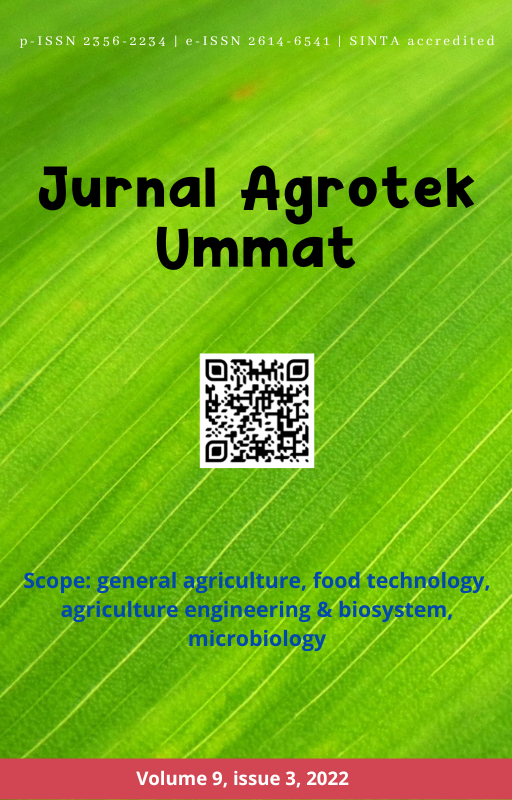Spatial analisys of physical characteristics of Jatiroke water catchment area Jatinangor Districs
DOI:
https://doi.org/10.31764/jau.v9i3.9507Keywords:
catchment area Jatiroke, Jatinangor, land use changes, watershed characteristicsAbstract
This research aim to identify the characteristics catchment area of jatiroke and present in the form of spatial data. The descriptive method was employed in this study. The results showed of Jatiroke catchment area was 5695,80 ha. Schmidt-Ferguson and Oldeman's classification of climate puts the climatic characteristics of the Jatiroke catchment area in the same group as type C and type C3. The Jatiroke catchment area has an elongated and narrow shape (like a bird feather), which impacts the amount of water that enters the river. The Jatiroke catchment area has an elongated and narrow drainage pattern and is shaped like a bird's feather based on the characteristics of the watershed. Land cover in the Jatiroke catchment area is dominated by forest mixed covering an area of 1615 ha with a percentage of 28%. Andosol and Kambisol soil types are found in the Jatiroke catchment area. Kambisol soil type dominates with an area of 3245.57 ha with a percentage of 57% of the total area. The slope of the Jatiroke catchment area is dominated by moderately steep and steep slope classes with an area of 3905.4 ha and 3278.2 ha, respectively, with an area presentation of 27.75% and 23.29%.
References
Arsyad, S. (2012). Konservasi Tanah dan Air. Bogor: IPB Press.
BPS Kabupaten Sumedang. (2018). Kabupaten Sumedang Dalam Angka 2018. Kabupaten Sumedang: CV Setia Abadi-Bandung.
Chaudhari, R. R., Ahire, D. V, Chkravarty, M., & Maity, D. (2013). Soil Bulk Density as related to Soil Texture, Organic Matter Content and available total Nutrients of Coimbatore Soil. International Journal of Scientific and Research Publications, 3(2).
Faski, G. I. S. L., Purnama, I. L. S., & Suprayogi, S. (2021). Analisis Karakteristik Fisik dan Meteorologi DAS Bengkulu. Megasains, 12(2), 27–34.
Fauzi, R. G. N., Utomo, D. H., & Taryana, D. (2018). Pengaruh Perubahan Penggunaan Lahan Terhadap Debit Puncak di Sub DAS Penggung Kabupaten Jember. Jurnal Pendidikan Geografi, (1), 50–61.
Hasan, S., Shi, W., Zhu, X., Abbas, S., & Khan, H. U. A. (2020). Future Simulation of Land Use Changes in Rapidly Urbanizing South China Based on Land Change Modeler and Remote Sensing Data. Sustainability, 12(11), 4350.
Jacob, A. (2014). Adaptabilitas Jagung Putih pada Tanah Regosol dan Kambisol yang Diberi Kopos Ela Sagu. Buana Sains, 14(2), 61–70.
Kananta, S. (2020). Evaluasi Kemampuan Lahan untuk Arahan Penggunaan Lahan di Daerah Aliran Sungai Maros Sulawesi Selatan. Jurnal Agrotek UMMAT, 7(1), ISSN 2614-6541.
Kay, B. D., & Angers, D. A. (2000). Soil structure. In M. E. Summer (ed.). Handbook of Soil Science. Boca Raton-London-New YorkWashington D.C: CRC Press.
Kharistya, A., Bafdal, N., & Abidin, J. (2013). Penentuan Tingkat Bahaya Erosi dengan Menggunakan Sistem Informasi Geografis di Sub DAS Cikeruh Kabupaten Bandung-Sumedang. Jurnal Teknologi Pertanian, 7(3), ISSN 1978-1067.
Permatasari, R. (2017). Pengaruh Perubahan Penggunaan Lahan terhadap Rezim Hidrologi DAS ( Studi Kasus : DAS Komering ). Jurnal Teknik Sipil, 24(1), 91–98.
Salim, A. G., Dharmawan, I. W. S., & Narendra, B. H. (2019). Pengaruh Perubahan Luas Tutupan Lahan Hutan Terhadap Karakteristik Hidrologi DAS Citarum Hulu. Jurnal Ilmu Lingkungan, 17(2), 333–340.
Shaikh, M., & Birajdar, F. (2015). Analysis of Watershed Characteristics Using Remote Sensing and GIS Techniques. IJIRSET, 4(4), ISSN: 2319-8753.
Staddal, I. (2016). Analisis Aliran Permukaan Menggunakan Model SWAT di DAS Bila Sulawesi Selatan. Jurnal Teknik Sipil, 4(1), 57–63.
Sukarman, & Dariah, A. (2014). Tanah Andosol di Indonesia Karakteristik, Potensi, Kendala dan Pengelolaannya untuk Pertanian (1st ed.). Balai Besar Penelitian dan Pengembangan Sumberdaya Lahan Pertanian.
Tarigan, S., Stiegler, C., Wiegand, K., Knohl, A., & Murtilaksono, K. (2020). Relative Contribution of Evapotranspiration and Soil Compaction to The Fluctuation of Catchment Discharge: Case Study From a Plantation Landscape. Hydrological Sciences Journal, 65(7), 1239–1248.
Utomo, D. H. (2016). Pengembangan Bahan Ajar Meteorologi-Klimatologi Berdasarkan Brain Based Learning. Malang: Program Studi Pendidikan Geografi, Universitas Negeri Malang.
Verrina, G. P., Anugerah, D. D., & Haki, H. (2013). Analisa Runoff Pada Sub Das Lematang Hulu. Jurnal Teknik Sipil Dan Lingkungan, 1(1).
Downloads
Published
Issue
Section
License
Authors who publish articles in Jurnal Agrotek Ummatagree to the following terms:- Authors retain copyright of the article and grant the journal right of first publication with the work simultaneously licensed under a CC-BY-SA or The Creative Commons Attribution–ShareAlike License.
- Authors are able to enter into separate, additional contractual arrangements for the non-exclusive distribution of the journal's published version of the work (e.g., post it to an institutional repository or publish it in a book), with an acknowledgment of its initial publication in this journal.
- Authors are permitted and encouraged to post their work online (e.g., in institutional repositories or on their website) prior to and during the submission process, as it can lead to productive exchanges, as well as earlier and greater citation of published work (See The Effect of Open Access).

